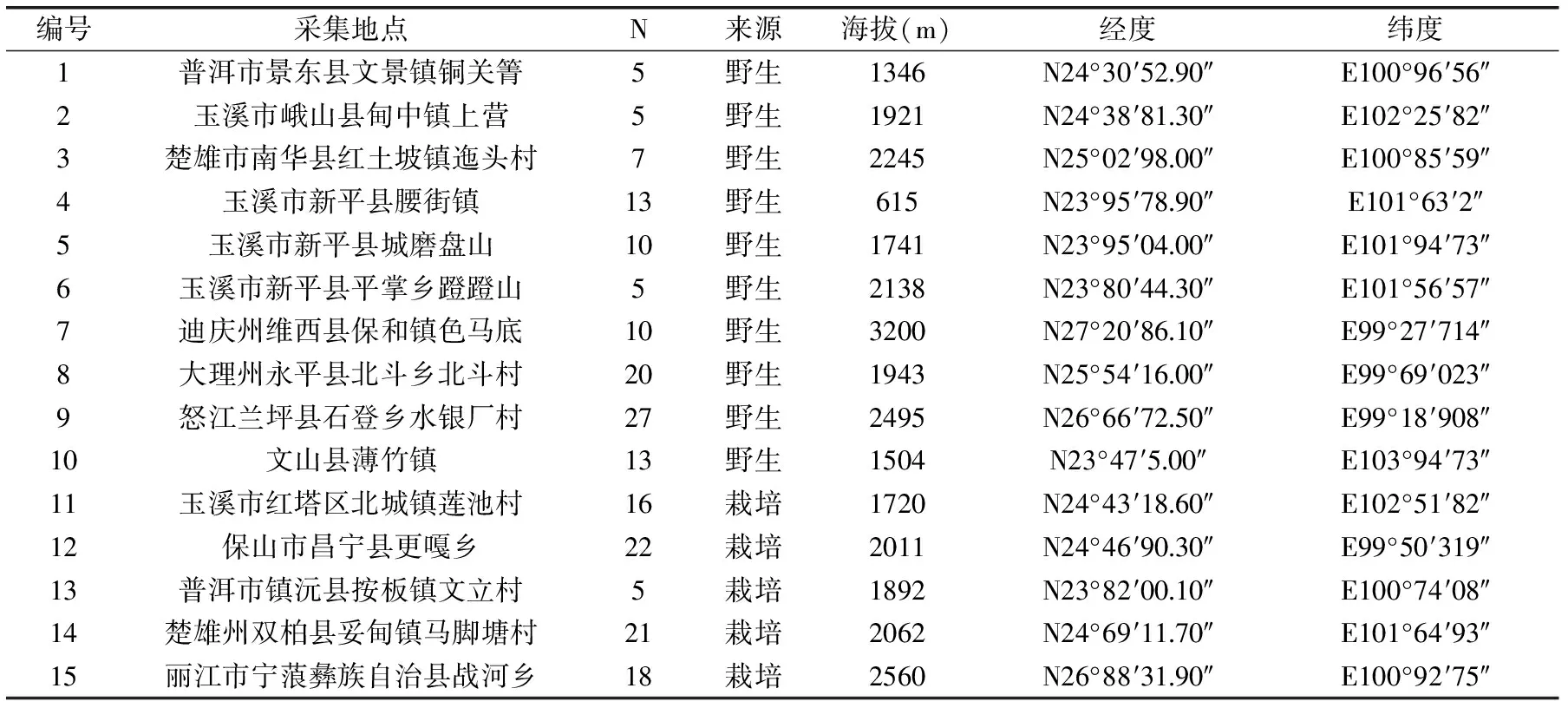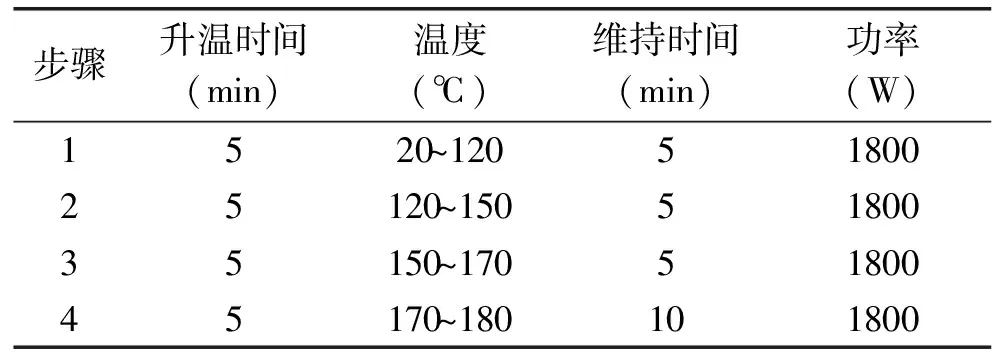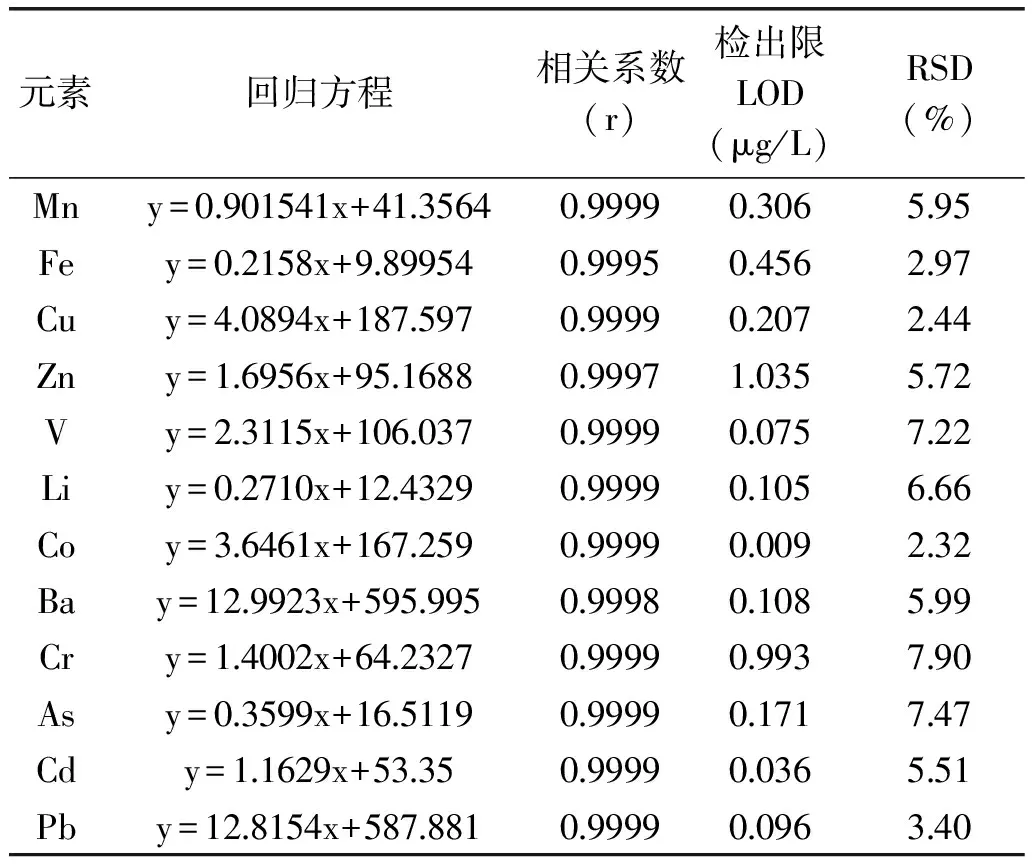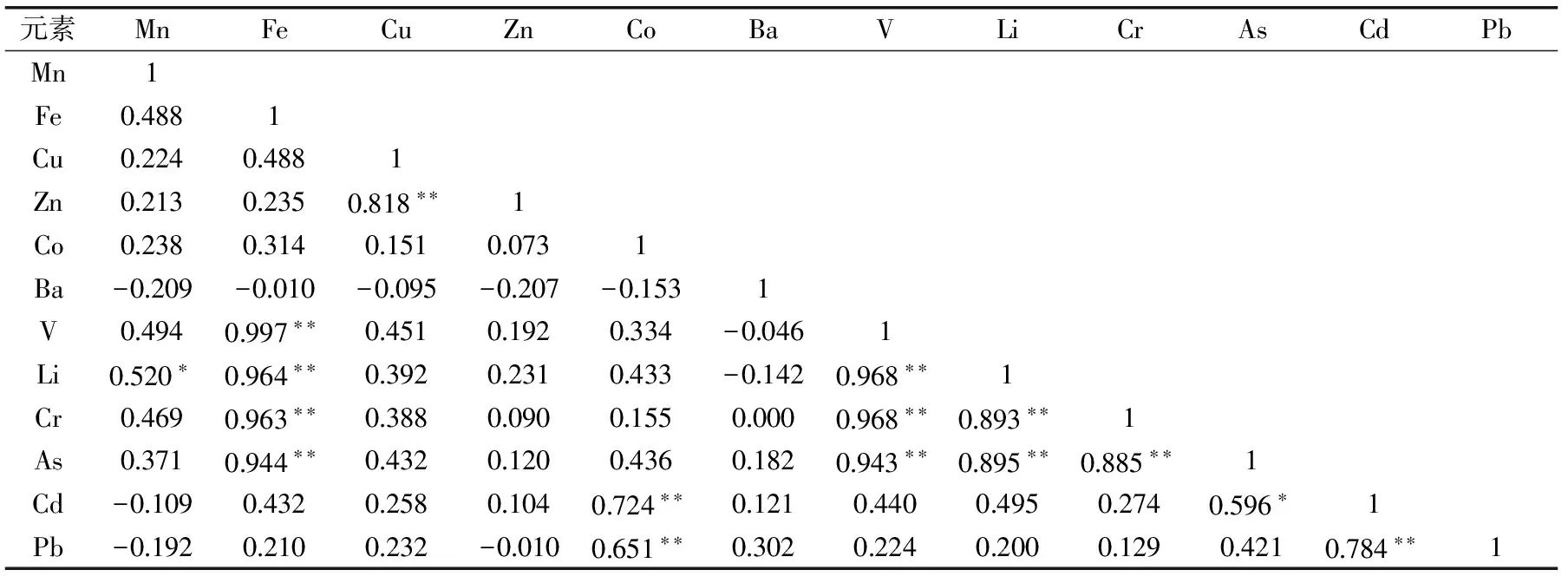云南野生与栽培茯苓中矿质元素含量研究
邢 博,张 霁,李杰庆,王元忠,*,刘鸿高,*
(1.云南农业大学农学与生物技术学院,云南昆明 650201;2.云南省农业科学院药用植物研究所,云南昆明 650200;3.云南省省级中药原料质量监测技术服务中心,云南昆明 650200)
云南野生与栽培茯苓中矿质元素含量研究
邢 博1,2,张 霁2,3,李杰庆1,王元忠2,3,*,刘鸿高1,*
(1.云南农业大学农学与生物技术学院,云南昆明 650201;2.云南省农业科学院药用植物研究所,云南昆明 650200;3.云南省省级中药原料质量监测技术服务中心,云南昆明 650200)
建立微波消解-电感耦合等离子体质谱法(ICP-MS)测定云南15个产地野生与栽培茯苓菌核中Fe、Mn、Cu、Zn、Co、Li、V、Ba、Cr、As、Cd、Pb等12种矿质元素,探讨茯苓中矿质元素的含量分布特征。采用SPSS 21.0进行主成分分析和相关性分析。结果显示,线性回归方程相关系数r均大于0.9990,检出限范围在0.009~1.035 μg/L之间,参考物菠菜(GBW10015)和灌木枝叶(GBW07603)测定值在国家参考标准值范围内,表明该方法准确、可靠。所测样品中含有丰富的矿质元素,栽培种Fe、Mn、Co、V、Cr等元素含量高于野生;野生和栽培菌核中Fe元素含量范围分别为31.86~108.3、49.71~805.62 mg/kg,Mn元素含量分别为5.59~35.6、12.9~67.7 mg/kg;Cu、Zn和Ba元素平均含量在1~10 mg/kg之间;Co、Li、V、As、Cd、Pb、Cr等均小于1 mg/kg,其中As(<0.16 mg/kg)、Cd(<0.03 mg/kg)、Pb(<0.35 mg/kg)等有毒重金属均低于食品安全国家标准、世界卫生组织(WHO)和《中国药典》(2015版)最高限量。第一主成分解释原始数据变量的49.060%,Mn、Fe、V、Li、As、Cr等元素载荷值较大,茯苓中特征元素为Mn、Fe、V、Li、As、Cr。相关性分析显示14对矿质元素呈现显著相关(p<0.05)或极显著相关(p<0.01)。元素在茯苓生长过程中存在内在的相关关系,不同产地样品中元素含量差异显著,可能与降水、温度、生长的土壤环境和生长方式有关。
茯苓,电感耦合等离子体质谱法(ICP-MS),矿质元素,主成分分析,相关性分析
食(药)用菌含有丰富的蛋白质、维生素、矿质元素、膳食纤维素等营养物质,及多糖类、核苷类、生物碱类、呋喃衍生物类等功效成分,其丰富的营养物质,独特的风味,特殊的食药用价值,深受各国消费者的喜爱[1-3]。

表1 茯苓样品信息
Fe、Mn、Cu、Zn等元素是人体内某些活性蛋白、酶、激素等的重要组成成分,是维持生理活动不可缺少的物质,对机体代谢有着极其重要的作用,在人体内无法合成,需从食物中获取[4-6]。食(药)用菌在生物地球化学循环和元素循环中起着重要作用,能够吸收、积累、转化和转移多种矿质元素[7]。子实体内富集的大量和微量元素可作为调节血液和组织渗透压平衡的多种辅酶因子[8-10],具有维持人体的正常生理机能、促进生长发育及抵抗疾病等多种功能[11]。研究发现大型真菌具有较强的元素富集能力[12-14],且对重金属元素富集能力高于蔬菜和水果[15]。
茯苓(Wolfiporiaextensa)为多孔菌科真菌茯苓的干燥菌核,多依附在松科植物赤松或马尾松的根部生长[16]。作为食品和药品在亚洲许多国家都有广泛的应用[17-20]。据第3次全国中药资源普查统计,茯苓的配伍率达70%以上。在中国,茯苓点心、云片白雪糕、八珍茯苓糕、长寿挂面等产品在市场上随处可见,深受人们的喜爱。该物种主要分布在云南、湖北、安徽、湖南等省,在云南被称为“云苓”,是我国道地产区之一[21-23]。目前主要研究关于营养成分及药用价值,其矿质元素的测定分析相对较少,主要集中在放射性及重金属元素方面。
本文采用微波消解结合电感耦合等离子体质谱法(ICP-MS)测定云南野生与栽培茯苓菌核中Fe、Mn、Cu、Zn、Co、Li、V、Ba、Cr、As、Cd、Pb等12种矿质元素的含量,利用SPSS进行主成分分析和相关性分析,有毒重金属元素与食品安全国家标准、世界卫生组织(WHO)和国家药典(2015版)最高限量进行比较,对云南省茯苓中矿质元素含量整体评价,从元素角度探讨食用安全性,为消费者提供健康保障。
1 材料与方法
1.1 材料与仪器
茯苓样品于2014年采自云南省15个地区(详细信息见表1)。由云南农业大学刘鸿高教授鉴定为多孔菌科茯苓属真菌茯苓Wolfiporiaextensa(Peck)Ginns,保存于云南农业大学菌物研究所样品室;每个地区采集样品数量≥5;器皿均用10% HNO3溶液浸泡过夜,超纯水清洗,烘干备用。
微波消解仪Mars6 美国CEM公司;ICP-MSNexION300 美国安捷伦公司;AR1140型万分之一分析天平 梅特勒-托利多仪器(上海)有限公司;100目标准筛盘 浙江上虞市道墟五四仪器厂;超纯水(电阻率>18.25 MΩ·cm);65%浓硝酸(优级纯)和30%过氧化氢(分析纯) 西陇化工股份有限公司;矿质元素标准溶液 济南众标科技有限公司;参考物菠菜(GBW10015)和灌木枝叶(GBW07603) 地球物理地球化学勘察研究所。
1.2 实验方法
1.2.1 样品消解 新鲜茯苓样品用不锈钢刀和毛刷清理干净,分为白色的茯苓菌核和茯苓皮。所有样品在室温条件下阴半干或全干,置于烘箱中于50 ℃烘干后粉碎,过100目筛备用。精密称取样品0.2000 g于消解管中,加入6 mL硝酸和3 mL双氧水,放入微波消解仪中,对仪器的工作参数进行优化,按表2的参数至消解完全,冷却后转移至比色管中,用超纯水定容至25 mL,放置澄清后即可得样品待测液,采用相同方法制备空白对照和标准物质消解液。

表4 菠菜叶(GBW10015)和灌木枝叶(GBW07603)12种元素的测定结果(n=5)

表2 微波消解条件
1.2.2 建立标准曲线 取Fe、Mn、Cu和Zn等元素的标准储备液,加体积分数5%的HNO3溶液配制成0、0.5、1、2、5、10、20 μg/mL的混合标准液,用于测定Fe、Mn、Cu和Zn元素的标准曲线。取Co、Li、V、Ba、Cr、As、Cd和Pb元素标准储备液,加体积分数5%的HNO3溶液,配制成0、0.01、0.02、0.05、0.1、0.5、1 μg/mL的混合标准液。标准曲线方程如表3所。
1.2.3 元素含量测定 对仪器的工作参数进行优化,得到ICP-MS最佳的仪器工作条件,射频功率1300 W,等离子体气流量15 L/min,载气流量1.6 mL/min,采样深度6.5 mm,进样速率0.1 mL/min。其中等离子气、辅助气、雾化气均为高纯氩。按照选定的仪器工作条件,取样液直接测定各元素含量,各试样重复测定3次。
1.3 数据处理
实验数据应用Microsoft Excel 2007对数据进行初步处理,计算不同产地茯苓中矿质元素的平均含量,并用SPSS 21.0系统进行主成分分析和相关性分析。
2 结果与分析
2.1 方法验证
根据茯苓中不同元素的含量,选择合适的浓度范围绘制元素标准曲线方程(表3)。12种元素的线性回归方程相关系数r均大于0.9990。对空白样品测量所得的标准偏差的3倍计算各元素的检出限,检出限在0.009~1.035 μg/L范围内,计算测定方法的相对标准偏差(RSD),结果表明RSD值均小于8%。采用国家标准菠菜参考(GBW10015)和灌木枝叶(GBW07603)对ICP-MS法进行验证。由表4可知,矿质元素的测定值都在国家标准参考值范围内。表明该方法准确、可靠,适用于茯苓中矿质元素的测定。

表3 元素线性回归方程、相关系数、检出限和RSD
2.2 茯苓中12种矿质元素含量分析
茯苓菌核中Fe、Mn、Cu、Zn、Co、Li、V、Ba、Cr、As、Cd、Pb等12种元素含量的均值见表5。结果表明,所测元素含量因采集地不同差异明显,含有丰富的Fe、Mn、Cu、Zn等矿质元素。

表5 栽培与野生茯苓中矿质元素含量(mg/kg)
注:ND表示未检测到。Fe是菌核中含量最丰富的元素;Mn元素次之;Cu、Zn和Ba的平均含量在1~10 mg/kg之间;Co、Li、V、As、Cd、Pb、Cr的平均含量均小于1 mg/kg。栽培与野生中元素含量差异显著,可能与降水、温度等气候条件的差异性有关,与其所生长的土壤环境、地质地貌及人为等因素有关。
2.2.1 Fe、Mn含量 栽培和野生样品中Fe含量分别为31.86~108.3,49.71~805.62 mg/kg,Mn元素平均含量为5.59~35.6、12.9~67.7 mg/kg,栽培茯苓Fe、Mn元素的含量略高于野生样品。Li[24]测定云南绒柄牛肝菌中Fe元素含量均值为121 mg/kg,Liu[25]研究云南10种野生食用菌中Fe、Mn元素的含量为1.4~70、22~510 mg/kg,Liu等[26]测定食用菌Fe、Mn元素含量为1.54~110.5、2.00~826.5 mg/kg,Fe、Mn含量与文献报道的食用菌相近。




表6 GB 2762-2012、WHO和中国药典标准(mg/kg)
2.3 茯苓中12种矿质元素主成分分析
对15个地区的茯苓样品12种矿质元素含量测定值标准化后进行主成分分析(表7),载荷图见图1。由表7可知,本文选取的4个主成分的累积贡献率为91.406%,即保留了原始指标91.406%的信息,具有代表性。第一主成分的特征值为5.887,解释原始数据变量的49.060%,Mn、Fe、V、Li、As、Cr等在指标上的载荷比较大,说明Mn、Fe、V、Li、As、Cr等元素对第一主成分有较高的贡献率。第二主成分的特征值为2.199,累计贡献率为67.389%,Co、Cd、Pb在指标上的载荷比较大,表明Co、Cd、Pb在第二主成分有较高的相关性。第三、第四主成分的特征值为1.604、1.165,累计贡献率分别为80.75%、91.406%,由表7可以看出,第三和第四主成分反映了Cu、Zn、Ba等元素的信息。因总方差49.060%的贡献率来自第一个主成分因子,故认为茯苓中特征元素为Mn、Fe、V、Li、As和Cr。

表8 茯苓中12种元素的相关性分析
注:*表示p<0.05显著相关,**表示p<0.01极显著相关。

表7 茯苓矿质元素主成分分析结果

图1 茯苓中元素主成分分析载荷图Fig.1 The loading plot of the first three principal components of W. extensa
2.4 茯苓中12种矿质元素相关性分析
实验测定茯苓中12种矿质元素含量进行相关性分析,如表8所示,14对矿质元素呈现显著相关(p<0.05)或极显著相关(p<0.01)。Fe与V、Li、Cr、As;V与Li、Cr、As;Co与Cd、Pb,呈极显著相关,系数最高为0.997。Cu与Zn、Cr与As、Cd与Pb等呈极显著相关,系数范围在0.651~0.968。Mn与Li、As与Cd呈显著相关,相关系数为0.520、0.596。元素间相关性较强,表明此类元素在茯苓生长过程中存在内在的相关关系。
3 结论
本实验采用ICP-MS法,对云南省15个地区野生与栽培茯苓野中12种矿质元素含量进行测定,不同产地茯苓样品中元素含量差异明显,可能与降水、温度等气候条件的差异性有关,与其所生长的土壤环境、地质及地貌等因素有关。栽培茯苓中Fe、Mn、Co、V、Cr等元素含量高于野生茯苓,Cu、Zn元素在两者中含量接近。Fe是菌核中含量最丰富的元素;Mn元素次之;Cu、Zn和Ba的平均含量在1~10 mg/kg之间;Co、Li、V、As、Cd、Pb、Cr的平均含量均小于1 mg/kg。茯苓菌核含有丰富的Fe、Mn等矿质元素对人体免疫功能的维护、新陈代谢等生命活动有重要作用,可作为人体日常矿质元素的来源。含有的As、Cd、Pb等有毒重金属低于国家标准、WHO、中国药典规定的最高限量。
对茯苓中12种元素的主成分分析结果显示,本文选取的4个主成分的累积贡献率为91.406%,总方差49.060%的贡献率来自第一主成分因子,故可认为茯苓中特征元素为Mn、Fe、V、Li、As和Cr。相关性分析显示14对矿质元素呈现显著相关(p<0.05)或极显著相关(p<0.01),元素间相关性较强。相关性分析结果与主成分分析结果一致,表明此类元素在茯苓生长过程中存在内在的相关关系,可能与茯苓的生长方式有关。
[1]Aquilano K,Baldelli S,Rotilio G,et al.Role of nitric oxide synthases in Parkinson’s disease:a review on the antioxidant and anti-inflammatory activity of polyphenols[J]. Neurochemical research,2008,33(12):2416-2426.
[2]Sudha G,Vadivukkarasi S,Shree R B I,et al.Antioxidant activity of various extracts from an edible mushroom Pleurotus eous[J]. Food Science and Biotechnology,2012,21(3):661-668.

[4]Prasad M N V. Trace elements as contaminants and nutrients:consequences in ecosystems and human health[M]. John Wiley & Sons,2008.
[5]Gregorio G B,Senadhira D,Htut T,et al. Improving iron and zinc value of rice for human nutrition[J]. Agriculture et Development,1999,23(9):77-81.
[6]Kaim W,Schwederski B,Klein A. Bioinorganic Chemistry--Inorganic Elements in the Chemistry of Life:An Introduction and Guide[M]. John Wiley & Sons,2013.
[7]Wang X M,Zhang J,Wu L H,et al. A mini-review of chemical composition and nutritional value of edible wild-grown mushroom from China[J]. Food chemistry,2014,151:279-285.
[8]Podlasińska J,Proskura N,Szymańska A. Content of Pb,Hg,Zn,Mn,Cu,and Fe in Macrofungi Collected from Wkrzanska Forest in Northwestern Poland[J]. Polish Journal of Environmental Studies,2015,24(2):651-656.
[9]Szubstarska J,Jarzyńska G,Falandysz J. Trace elements in Variegated Bolete(Suillus variegatus)fungi[J]. Chemical Papers,2012,66(11):1026-1031.
[12]Podlasińska J,Proskura N,Szymańska A. Content of Pb,Hg,Zn,Mn,Cu,and Fe in Macrofungi Collected from Wkrzanska Forest in Northwestern Poland[J]. Polish Journal of Environmental Studies,2015,24(2).651-656.
[13]Drewnowska M,Falandysz J.Investigation on mineral composition and accumulation by popular edible mushroom common chanterelle(Cantharellus cibarius)[J].Ecotoxicology and environmental safety,2015,113:9-17.
[14]Falandysz J,Drewnowska M.Macro and trace elements in Common Chanterelle(Cantharellus cibarius)mushroom from the European background areas in Poland:Composition,accumulation,dietary exposure and data review for species[J].Journal of Environmental Science and Health,Part B,2015,50(5):374-387.

[16]吴兴亮,卯晓岚,图力古尔,等. 中国药用真菌[M]. 北京:科学出版社,2013:775-777.
[17]Ling Y,Chen M C,Wang K,et al. Systematic screening and characterization of the major bioactive components of Poria cocos and their metabolites in rats by LC-ESI-MSn[J]. Biomedical Chromatography,2012,26(9):1109-1117.
[18]Lu M K,Cheng J J,Lin C Y,et al. Purification,structural elucidation,and anti-inflammatory effect of a water-soluble 1,6-branched 1,3-α-D-galactan from cultured mycelia of Poria cocos[J]. Food Chemistry,2010,118(2):349-356.
[19]Lee K Y,Jeon Y J. Polysaccharide isolated from Poria cocos sclerotium induces NF-κB/Rel activation and iNOS expression in murine macrophages[J]. International immunopharmacology,2003,3(10):1353-1362.
[20]戴玉成,周丽伟,杨祝良,等. 中国食用菌名录[J]. 菌物学报,2010(1):1-21.
[21]於小波,昝俊峰,王金波,等. 我国茯苓药材主要产区资源调查[J]. 时珍国医国药,2011,22(3):714-716.
[22]Yang Z. On wild mushroom resources and their utilization in Yunnan Province,Southwest China[J]. Journal of Natural Resources,2001,17(4):463-469.
[23]Yang Y,Tian K,Hao J,et al. Biodiversity and biodiversity conservation in Yunnan,China[J]. Biodiversity & Conservation,2004,13(4):813-826.
[24]Li T,Wang Y Z,Zhang J,et al. Trace element content of Boletus tomentipes mushroom collected from Yunnan,China[J]. Food Chemistry,2011,127:1828-1830.
[25]Liu H,Zhang J,Li T,et al. Mineral element levels in wild edible mushrooms from Yunnan,China[J]. Biological Trace Element Research,2012,147(1-3):341-345.
[26]Liu B,Huang Q,Cai H,et al. Study of heavy metal concentrations in wild edible mushrooms in Yunnan Province,China[J]. Food Chemistry,2015,188:294-300.

[28]Mazurkiewicz N,Podlasińska J. Bioaccumulation of trace elements in wild-growing edible mushrooms from Lubuskie voivodeship,Poland[J]. Chemistry and Ecology,2014,30(2):110-117.
[29]Cvetkovic J S,Mitic V D,Stankov-Jovanovic V P,et al. Elemental composition of wild edible mushrooms from Serbia[J]. Analytical Letters,2015,48(3):2107-2121.
[30]Kovács D,Vetter J. Chemical composition of the mushroom Laetiporus sulphureus(Bull.)Murill[J]. Acta Alimentaria,2015,44(1):104-110.
[31]Nnorom I C,Jarzyńska G,Drewnowska M,et al. Major and trace elements in sclerotium of Pleurotus tuber-regium(ósū)mushroom-Dietary intake and risk in southeastern Nigeria[J]. Journal of food composition and analysis,2013,29(1):73-81.
[32]Mleczek M,Siwulski M,Mikoajczak P,et al. Bioaccumulation of elements in three selected mushroom species from southwest Poland[J]. Journal of Environmental Science and Health,Part B,2015,50(3):207-216.
[33]Drewnowska M,Falandysz J. Investigation on mineral composition and accumulation by popular edible mushroom common chanterelle(Cantharellus cibarius)[J]. Ecotoxicology and environmental safety,2015:113,9-17.
[34]Falandysz J,Kunito T,Kubota R,et al. Multivariate characterization of elements accumulated in King Bolete Boletus edulis mushroom at lowland and high mountain regions[J]. Journal of Environmental Science and Health,Part A,2008,43(14):1692-1699.
[35]Quarcoo A,Adotey G,Gordon A. Detection and quantification of trace elements(chromium,vanadium,selenium)in some Ghanaian mushrooms using atomic absorption spectrometry[J]. Current Research in Environmental and Applied Mycology,2014,4(1):142-148.
[36]Tel G,Çavdar H,Deveci E,et al. Minerals and metals in mushroom species in Anatolia[J]. Food Additives and Contaminants:Part B,2014,7(3):226-231.
[37]Zhang J,Liu H G,Li S J,et al. Arsenic in edible and medicinal mushrooms in Southwest China[J]. International Journal of Medicinal Mushrooms,2015,17(6):601-605.
[38]Fang Y,Sun X Y,Yang W J,et al. Concentrations and health risks of lead,cadmium,arsenic,and mercury in rice and edible mushrooms in China[J]. Food Chemistry,2014,147:147-151.
[39]中华人民共和国卫生部. GB 2672-2012 食品安全国家标准食品中污染物限量[S]. 北京:中国标准出版社,2013.
[40]World Health Organization. Guidelines for the assessment of herbal medicines[R]. WHO,Munich,Geneva,1991.
[41]国家药典委员会. 中国药典,Ⅰ部[S]. 中国医药科技出版社,2015:240.
Determination of mineral elements of wild and cultivatedWolfiporiaextensacollected from Yunnan
XING Bo1,2,ZHANG Ji2,3,LI Jie-qing1,WANG Yuan-zhong2,3,*,LIU Hong-gao1,*
(1.College of Agronomy and Biotechnology,Yunnan Agricultural University,Kunming 650201,China; 2.Institute of Medicinal Plants,Yunnan Academy of Agricultural Sciences,Kunming 650200,China; 3.Yunnan Technical Center for Quality of Chinese Materia Medica,Kunming 650200,China)
In order to study the distribution characteristics of mineral elements inWolfiporiaextensafrom Yunnan Province,12 elements of Fe,Mn,Cu,Zn,Co,Li,V,Ba,Cr,As,Cd and Pb in wild and cultivatedW.extensafrom 15 origins were determined using inductively coupled plasma mass spectrometer(ICP-MS)method. The quantitative results were analyzed by principle component analysis(PCA)and correlation analysis using SPSS 21.0 software. The results showed that the correlation coefficients(r)of linear regression equations were all higher than 0.999 and the detection limits were in range of 0.009~1.035 μg/L. Besides,the measured values of national standard reference of spinach(GBW 10015)and shrub leaves(GBW 07603)were within the standard range,demonstrating that this method could be used for the determination of mineral elements ofW.extensaaccurately and reliably. The results showed that the test samples were rich in mineral elements and the content of Fe,Mn,Co,V and Cr in cultivatedW.extensawere higher than that of the wild ones. In addition,the contents of Fe in wild and cultivated sclerotia were 31.86~108.3 and 49.71~805.62 mg/kg,and the contents of Mn were 5.59~35.6 and 12.9~67.7 mg/kg,respectively. The average amounts of Cu,Zn and Ba were 1~10 mg/kg. The average amounts of Co,Li,V,As,Cd,Pb and Cr were all less than 1.0 mg/kg and the contents of other toxic heavy metals,such as As(<0.16 mg/kg),Cd(<0.03 mg/kg),Pb(<0.35 mg/kg),were all lower than the maximum limit of the national food safety standard,World Health Organization(WHO)and Chinese Pharmacopoeia(2015 edition). The results of PCA showed that the first principal component factor can represent 49.060% total variance contribution. The loading values of Mn,Fe,V,Li,As and Cr were higher than that of other elements,which can be regard as the characteristic elements. Correlation analysis displayed that 14 pairs of mineral elements showed significant(p<0.05)or high significant correlation(p<0.01)and these elements have intrinsical relationships in the growth process inW.extensa.
Wolfiporiaextensa;ICP-MS;mineral elements;principle component analysis;correlation analysis
2016-06-17
邢博(1990-),男,硕士研究生,主要从事真菌资源方面的研究,E-mail:912380549@qq.com。
*通讯作者:王元忠(1981-),男,博士研究生,副研究员,主要从事药用真菌资源方面的研究,E-mail:boletus@126.com。刘鸿高(1974-),男,博士研究生,教授,主要从事野生食用菌资源方面的研究,E-mail:honggaoliu@126.com。
国家自然科学基金地区科学基金项目(31460538;31260496)。
TS201.2
A
1002-0306(2016)24-0000-00
10.13386/j.issn1002-0306.2016.24.000

